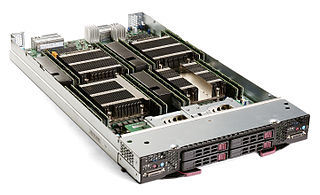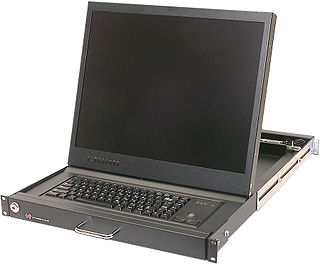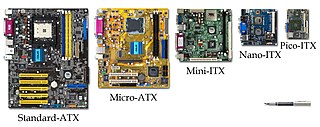Related Research Articles

A motherboard is the main printed circuit board (PCB) in general-purpose computers and other expandable systems. It holds and allows communication between many of the crucial electronic components of a system, such as the central processing unit (CPU) and memory, and provides connectors for other peripherals. Unlike a backplane, a motherboard usually contains significant sub-systems, such as the central processor, the chipset's input/output and memory controllers, interface connectors, and other components integrated for general use.

A 19-inch rack is a standardized frame or enclosure for mounting multiple electronic equipment modules. Each module has a front panel that is 19 inches (482.6 mm) wide. The 19 inch dimension includes the edges or ears that protrude from each side of the equipment, allowing the module to be fastened to the rack frame with screws or bolts. Common uses include computer servers, telecommunications equipment and networking hardware, audiovisual production gear, music production equipment, and scientific equipment.

A single-board computer (SBC) is a complete computer built on a single circuit board, with microprocessor(s), memory, input/output (I/O) and other features required of a functional computer. Single-board computers are commonly made as demonstration or development systems, for educational systems, or for use as embedded computer controllers. Many types of home computers or portable computers integrate all their functions onto a single printed circuit board.

A laptop computer or notebook computer, also known as a laptop or notebook, is a small, portable personal computer (PC). Laptops typically have a clamshell form factor with a flat-panel screen on the inside of the upper lid and an alphanumeric keyboard and pointing device on the inside of the lower lid. Most of the computer's internal hardware is fitted inside the lower lid enclosure under the keyboard, although many modern laptops have a built-in webcam at the top of the screen, and some even feature a touchscreen display. In most cases, unlike tablet computers which run on mobile operating systems, laptops tend to run on desktop operating systems, which were originally developed for desktop computers.

A mobile data terminal (MDT) or mobile digital computer (MDC) is a computerized device used in emergency services, public transport, taxicabs, package delivery, roadside assistance, and logistics, among other fields, to communicate with a central dispatcher. They are also used to display mapping and information relevant to the tasks and actions performed by the vehicle such as CAD drawings, diagrams and safety information.

A blade server is a stripped-down server computer with a modular design optimized to minimize the use of physical space and energy. Blade servers have many components removed to save space, minimize power consumption and other considerations, while still having all the functional components to be considered a computer. Unlike a rack-mount server, a blade server fits inside a blade enclosure, which can hold multiple blade servers, providing services such as power, cooling, networking, various interconnects and management. Together, blades and the blade enclosure form a blade system, which may itself be rack-mounted. Different blade providers have differing principles regarding what to include in the blade itself, and in the blade system as a whole.

A computer case, also known as a computer chassis, is the enclosure that contains most of the hardware of a personal computer. The components housed inside the case are referred as the internal hardware, while hardware outside the case are known as peripherals.

ThinkCentre is a line of business-oriented desktop computers designed, developed and marketed by Lenovo, and formerly by IBM from 2003 to 2005. ThinkCentre computers typically include mid-range to high-end processors, options for discrete graphics cards, and multi-monitor support.

The Panasonic Toughbook is a line of rugged computers produced and marketed by Panasonic. The first model, the CF-25, was introduced in 1996. The Toughbook brand mainly competes with other lines of rugged computers, such as Dell's Rugged Extreme.

An ultra-mobile PC, or ultra-mobile personal computer (UMPC), is a miniature version of a pen computer, a class of laptop whose specifications were launched by Microsoft and Intel in Spring 2006. Sony had already made a first attempt in this direction in 2004 with its Vaio U series, which was only sold in Asia. UMPCs are generally smaller than subnotebooks, have a TFT display measuring (diagonally) about 12.7 to 17.8 centimetres, are operated like tablet PCs using a touchscreen or a stylus, and can also have a physical keyboard. There is no clear boundary between subnotebooks and ultra-mobile PCs, but UMPCs commonly have major features not found in the common clamshell laptop design, such as small keys on either side of the screen, or a slide-out keyboard.
A rugged computer or ruggedized computer is a computer specifically designed to operate reliably in harsh usage environments and conditions, such as strong vibrations, extreme temperatures and wet or dusty conditions. They are designed from inception for the type of rough use typified by these conditions, not just in the external housing but in the internal components and cooling arrangements as well.
An industrial control system (ICS) is an electronic control system and associated instrumentation used for industrial process control. Control systems can range in size from a few modular panel-mounted controllers to large interconnected and interactive distributed control systems (DCSs) with many thousands of field connections. Control systems receive data from remote sensors measuring process variables (PVs), compare the collected data with desired setpoints (SPs), and derive command functions that are used to control a process through the final control elements (FCEs), such as control valves.

An industrial PC is a computer intended for industrial purposes, with a form factor between a nettop and a server rack. Industrial PCs have higher dependability and precision standards, and are generally more expensive than consumer electronics. They often use complex instruction sets, such as x86, where reduced instruction sets such as ARM would otherwise be used.
In computing, the motherboard form factor is the specification of a motherboard – the dimensions, power supply type, location of mounting holes, number of ports on the back panel, etc. Specifically, in the IBM PC compatible industry, standard form factors ensure that parts are interchangeable across competing vendors and generations of technology, while in enterprise computing, form factors ensure that server modules fit into existing rackmount systems. Traditionally, the most significant specification is for that of the motherboard, which generally dictates the overall size of the case. Small form factors have been developed and implemented.

Microsoft Tablet PC is a term coined by Microsoft for tablet computers conforming to a set of specifications announced in 2001 by Microsoft, for a pen-enabled personal computer, conforming to hardware specifications devised by Microsoft and running a licensed copy of Windows XP Tablet PC Edition operating system or a derivative thereof.
WinSystems is an employee owned embedded systems manufacturer specializing in ruggedized, highly reliable industrial computer systems. The company was founded by Jerry Winfield in 1982 and is headquartered in Grand Prairie, Texas.

Computers can be classified, or typed, in many ways. Some common classifications of computers are given below.
CP Inc., doing business as Chassis Plans, is an American military and industrial computer systems manufacturer specializing in rackmount computers, military computers, rugged computers, industrial PCs, rackmount LCDs, single-board computer systems with passive and active backplanes and motherboard systems. Chassis Plans is a spin-off of Industrial Computer Source.

A KVM is a computer input/output device offering the combination of a keyboard, video monitor and mouse. They are typically constructed to fit into a 19-inch rack although there are manufacturers who offer a KVM that can be mounted to a flat surface such as a control console.

Form factor is a hardware design aspect that defines and prescribes the size, shape, and other physical specifications of components, particularly in electronics. A form factor may represent a broad class of similarly sized components, or it may prescribe a specific standard. It may also define an entire system, as in a computer form factor.
References
- ↑ 'Thinking inside the box: Boosting the effectiveness of air cooling' - Military Embedded Systems May 2008
- ↑ "'Heat Kills: Designing Rack mount Chassis for Optimal Cooling' COTS Journal September 2006". Archived from the original on 2007-09-27. Retrieved 2009-03-15.
- ↑ 'ip ratings' - Water Resistance Explained